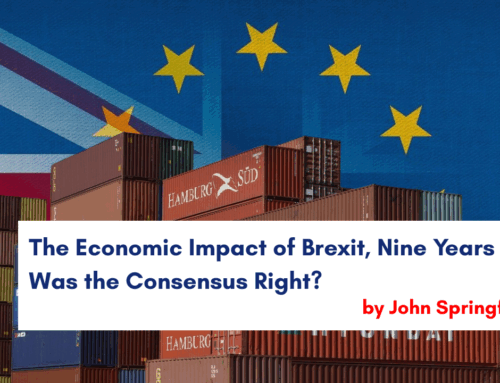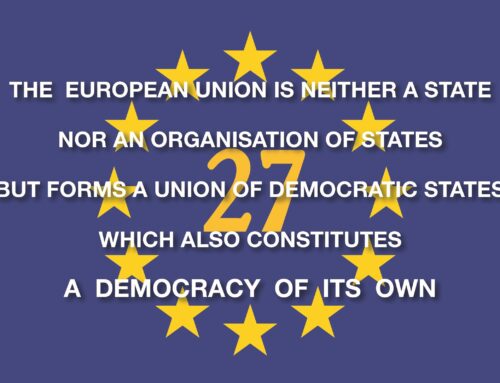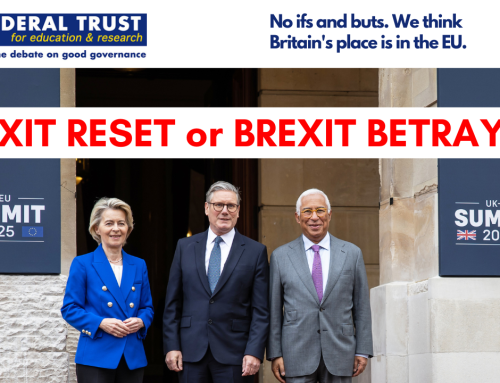Exiting Brexit: The possibilities
4th December 2018
 by Dr Andrew Blick
by Dr Andrew Blick
Dr Andrew Blick is Senior Lecturer in Politics and Contemporary History at King’s College London, where he is also Director of the Centre for British Politics and Government. He is a Senior Research Fellow at the Federal Trust.
Click here to download the paper in pdf format.
The Prime Minister hopes that her version of Brexit will ‘mark the point when we put aside the labels of “Leave” and “Remain” for good and we come together again as one people.’ The deal agreed with the EU 27 has indeed achieved coalescence between otherwise irreconcilable groups on either side of Brexit fissure. Unfortunately from the point of view of Theresa May, the focus for this unity is dislike of the proposal she has presented to them. If the deal is defeated[1], the default position remains that the UK leaves in the most disruptive fashion possible on 29th March 2019. There is even less support in the Commons for this outcome than there is for the negotiated exit. Any other course of action, however, would appear to involve revisiting the idea that the EU referendum of 23 June 2016 creates an irresistible obligation to leave. How, then, in such a circumstance, can the range of political options be widened?
The bulk of senior politicians in this country have depicted – some with regret, others with glee – the referendum result as decisive in determining the future of the UK. However, it was in no way legally binding, and there are a number of ways in which its political authority and democratic legitimacy can be challenged. At the time it took place the public were not – and could not be – fully aware of the nature of the choice that faced them. The binary nature of the question posed was not appropriate to the range of possibilities that the referendum engaged, particularly on the ‘leave’ side. A departure from the EU could lead to a broad spectrum of potential outcomes. For these reasons, it is difficult to claim that the vote of 2016 created a precise instruction on behalf of the UK as a whole to exit the UK on any given set of terms. Even if it had done so, it was not fully within the power of the UK to achieve them, since they involved securing the compliance of outside forces, in particular the EU and its 27 remaining member states.
Aside from what the result actually meant, support for ‘leave’, though constituting a majority of those who voted, was not resounding. The percentage split in favour of departure was relatively narrow: 51.9 per cent to 48.1 per cent. There were significant territorial disparities: London, Northern Ireland and Scotland all produced ‘remain’ results; and the vote entailed sharp divisions on various other lines, including age and level of formal educational attainment. For some, the integrity of the 2016 referendum has been called into question by revelations about misleading, unethical and illegal campaigning activities.
There are many grounds, then, on which it is possible to question the finality of the referendum result of 2016. By extension, a review of options undertaken following a Commons defeat for May should not be restricted by any supposed imperatives produced by this vote. However, views to this effect have – for obvious reasons – been expressed almost entirely by those who hope to reverse the commitment to exiting the EU that the UK government has taken ever since the ‘leave’ result that the popular vote produced. Yet now the credibility of the Brexit programme is subject to implicit challenge by politicians who are supportive of leaving.
Advocates of Brexit have been the most vehement critics of the deal May is presenting to Parliament. But the undoubtedly unpalatable nature of this agreement is not a consequence, as some seek to maintain, of poor negotiating tactics on the part of the UK. There were never any terms realistically on offer that would appear anything other than substantially inferior to membership of the EU. Nor was it ever a likely proposition that the UK would, in the given time frame and conditions, be able to secure any more than the vague statement of principle regarding a possible future Free Trade Agreement that she has obtained. The deal May has now secured represents the most concrete manifestation of this harsh reality to date. That it should be an occasion for such disappointment and even outrage is precisely because of the false expectations promoted regarding what could be achieved through Brexit.
As discussed in a previous Federal Trust paper by the present author, Hostages to Fortune: the unravelling of the Brexit prospectus, many specific claims made on behalf of the ‘leave’ agenda, both before and since the referendum, have since the vote took place been proved mis-founded. They include the assertion that it would be possible to deal directly with individual member states; and to ‘cherry-pick’ those aspects of EU membership that were perceived as suiting UK interests while rejecting others, without negative consequences for the degree of access to the Single Market. It was also asserted that not only an exit deal but also detailed progress on a Free Trade Agreement could be achieved within the Article 50 time-limit. There were even claims that the UK could commence the negotiation of trade deals with non-EU parties immediately. None of these bold predictions has become a reality. Ironically, it is some of the chief promoters of these illusions who have done most to expose them. May, though a (nominal) supporter of remain at the referendum, subsequently encouraged a view that an attractive arrangement was possible, and (unintentionally) exposed this fantasy through the very agreement she has now reached, though seeking to present it in the most favourable light possible. Those who have been the most enthusiastic exponents of Brexit before and after the June 2016 vote have also inadvertently revealed the fundamentally flawed nature of their – as it has transpired – unrealisable programme. Seemingly most of those parliamentarians who are willing to countenance the deal find it tolerable only in comparison to the preferred outcome of some of these vehement supporters of leaving: exit without any agreement.
But, as already noted, if May loses the crucial Commons vote (or votes), it will be precisely this most disruptive event that – in the absence of further intervention – will come about. Given that there is no majority for this occurrence in either House of Parliament, and taking into account the diminished credibility of the Brexit agenda in the wake of the May deal, it will be apt to consider possible means of changing direction. One option, that has always been a theoretical possibility, is that Parliament could impose a new policy itself. It could do so by insisting that the present government adhere to its wishes, or by installing a different administration that would do so. But Parliament has displayed to date a reluctance to challenge on its own account the idea that the 2016 referendum produced an incontrovertible verdict. Whether or not one finds such a conclusion satisfactory, some kind of additional mandate seems necessary to open up other policy options, including those that challenge the possibility of Brexit.
A means of doing so, at least according to the Labour Party and in particular its leadership, is to hold another General Election. But, even were there sufficient support in the Commons for bringing it about, there is not a clear reason to suppose that a further General Election would be any more effective at resolving the Brexit dilemma than that of June 2017. Even if a General Election produced a single-party majority, a General Election is not a suitable means of addressing a single issue. Moreover, if the Labour Party – as it hopes it would – secured a Commons majority, its apparent plan is to then reopen negotiations to secure a deal more favourable to the UK. This proposition is as flawed as the various misleading claims made by supporters of Brexit in the Conservative Party. The EU is clearly not open to this kind of adjustment, and – entirely reasonably – is unlikely to view itself as required to defer to an electoral mandate generated within a single, departing member state. Therefore, both a General Election and a renegotiation effort can be discarded. By elimination, in the event of Commons defeat for May, all that remains as a means of avoiding departure without a deal is a new referendum. Parliament has the power to bring it about, whether under May or a different Prime Minister, at the head of a single party or coalition government. A government forced or committed of its own volition to the policy of holding a further referendum would need to consider the following issues (I draw here on the recent work of the Constitution Unit[2], and my own earlier blog on the subject[3]):
Timing of the referendum. It may be judged practically impossible to hold a referendum before the end of March 2019. In this case, the UK may need to request an extension of the two-year period provided for under Article 50 of the Treaty on European Union. Whether or not the UK secured the unanimous agreement from member states required by the Article for a postponement of Brexit might depend on the way in which the referendum was being devised, and whether it offered at least a reasonable prospect of leading to the UK seeking to remain in the EU, assuming the EU 27 supported such a reversal.
The potential of unilaterally revoking Article 50. If remaining were an option on offer in the referendum, and if it were chosen by voters, the UK would then need to seek to revoke Article 50 to give effect to that decision. The Article, however, is silent on whether it can be deactivated, and if so, whether the single member state involved can do so alone, or whether it is a matter for the whole EU. In a case brought to resolve this matter, the EU Advocate General has now delivered the opinion that it should be possible for a member state that has triggered the Article subsequently to reverse this decision. However, this view is not binding and will be confirmed or contradicted subsequently by the Court of Justice of the European Union.
The referendum legislation. The timetable for such a measure would be tight, and the urgency of the task must be weighed against the need for proper scrutiny of the bill. That the legislation will be introduced and will pass assumes government commitment, backed by a consistent majority in the Commons (the Lords would presumably be relatively compliant regarding the general principle, though would countenance amending a bill).
Legal status of the result. It may be judged necessary to make the result legally binding – in contrast to that of 2016. For instance, were remaining an option and were it chosen, the referendum legislation could require the government to issue a revocation of Article 50 (subject to the discussion above about the legality of such an action). Such provision would seem sensible as a means of removing doubt about the outcome.
The possibility of litigation. Legal challenges of some kind to the referendum and its result are likely, whatever the outcome. The government will need to consider the possible uncertainties and obstacles that could thereby arise.
Regulation of the campaign. It will be necessary to consider what steps, if any, could be taken to avoid a recurrence of complaints regarding campaign activities and definite rule-breaking during the 2016 referendum, involving misleading claims, funding irregularities and the misuse of personal data. Another subject that will require consideration will be the role of government in the campaign. Might it wish to take a side – perhaps in support of the deal, if that is an option – and if so, what role will be appropriate for it to play? Will there be official lead campaigns, as provided for under the Political Parties, Elections and Referendums Act 2000? If it is a three-option referendum, will there be three campaigns? If there are two stages of voting held on different days, how far apart should they be, and what regulatory issues might such an arrangement create? Would, for instance, the publication of opinion polls between the first and second stages be restricted in some way?
The franchise. Firm supporters of leaving will surely firmly support the use of the same franchise as at the first referendum: excluding 16 and 17-year olds and EU citizens from other member states who are resident in the UK. They will claim that to use a wider franchise is a deliberate attempt to slant the contest against them. Yet denying these groups the right to vote the first time could equally well be seen as seeking to please those who sought to favour the ‘leave’ side. ‘Leave’ enthusiasts would point to the use of a more expansive franchise when claiming that the second referendum lacks legitimacy. However, it could just as well be argued that a more inclusive electorate would heighten the democratic credentials of the vote. The decision to hold a referendum will entail consigning the most forceful group of Conservative Eurosceptic MPs to a more marginal political position, commensurate with their actual numbers and discredited position, rather than the attention they generate. The previous referendum was held using a franchise that reflected their requirements. The next need not. However, politically it seems likely that it will.
The legitimacy of the result. Aside from its legal status, it is necessary to consider whether the practical legitimacy of a referendum would be damaged by, for instance, a boycott by ‘leave’ supporters. Would a lower turnout than in June 2016 harm the credibility of the exercise? A narrower margin of victory, in percentage terms, than was secured on this occasion seems unlikely, but if it was the outcome, might be a problem. If, in a two-option vote, ‘remain’ won, perhaps by a larger margin than ‘leave’ in 2016, but received a lower total number of votes than ‘leave’ had on this previous occasion, questions would be raised about how far this result should be regarded as decisive.
The question or questions to be put, and the way it or they will be answered. These issues would be the central concern for those instigating a second referendum. The following discussion operates on the premise that the referendum will have to offer a choice between two or more options, rather than simply asking voters to accept or reject one course of action (such as the present deal). What will those options be? To exclude remaining as an option would be a travesty of the logic underlying the vote: that the original result was insufficient in itself as a basis for final UK departure from the EU. If leaving without a deal were omitted, then the chances of the referendum providing a decisive political resolution of the Brexit episode would be reduced. To offer leaving on the terms secured in negotiations with the EU is a more complicated proposition. The government might wish to do so (assuming it is still the same government that holds office at present). But the new referendum would presumably be taking place in the context of the Commons having rejected the deal, and arguably having ruled it out, if the views of elected representatives are held to be of consequence.
A further observation needs to be made about these three potential options. It is possible broadly to know what remaining within the EU involves, (though the nature of the organisation will continue to change in future). The precise nature of departure without a deal, both in its immediate and longer-term connotations, is difficult to predict. Furthermore, it would need to be recognised and made clear to voters in advance of a further referendum that leaving with no deal could precipitate serious challenges to the Union and possibly its dissolution, depending on circumstances in particular in Scotland and Northern Ireland. For the third option discussed here, leaving with the negotiated deal, while there is a detailed Withdrawal Agreement (though probably too detailed for the purposes of a referendum), the future relationship with the EU is the subject only of a vague political statement. There is no precise guarantee about what kind of Free Trade Agreement will be achieved, or that any will be attained at all.
If a two-option referendum is held, then perhaps it would simply be necessary to accept a bare majority of those taking part as decisive. The use of thresholds or supermajorities, or to take into account the way in which each of Wales, Scotland, Northern Ireland and England voted in some way, would be problematic. Such devices might have been desirable in 2016 as a means of ensuring that Brexit could take place only subject to a heightened level of consent. However, to seek now to apply criteria of this kind would be to court plausible charges of elite manipulation. Those who seek to prevent Brexit should accept that they need to win the popular vote across the UK.
A three-option referendum presents greater complexities. One possible approach would be to hold a single-stage process in which each voter was able to pick one of the choices. The option that received the most votes would win. However, this method would create the strong possibility that the decision was made on a basis of a minority of total votes cast, compromising its sense of finality. A one-stage vote could also allow voters to mark preferences of 1 and 2. If one option received over half of first preferences, it would win. If not, the option that received the fewest would be eliminated and its second preferences redistributed between the other two. One problem with this approach is that it could mean the choice that came second on first preferences ultimately winning, again calling into question its political force. Furthermore, an option that could have defeated either of the other options in a straight contest with it might receive the fewest first preferences and be rejected irrespective of its ability to win in this sense.
Another approach to a three-option vote could be to allow for the possibility of two stages, either held at the same time, or on separate days. The first stage could offer a choice between, for instance, remaining or leaving. If voters chose leaving, then that could be the decision. However, if they chose to leave, a second stage could offer a choice between leaving without a deal or leaving with a deal. There are a number of variants on this approach. For instance, the first stage might ask voters to choose their favoured variant on leaving, and then the second stage could ask them to choose between the option chosen and remaining. Decisions about structuring this kind of process are inevitably of an arbitrary character, and have consequences for the likely outcome. They also involve voters having to second guess the outcome of a second stage when making their decision for the first.
The conclusion that can be drawn is that the most satisfactory referendum would involve a straight choice between two options. The use of a binary choice in June 2016 was problematic not because this type of question is necessarily flawed, but because it was asked at a time when knowledge about the meaning of leaving was lacking at this stage. Subsequent events have to some extent corrected this problem. Given that the scenario in which a new referendum came about would be one in which the deal with the EU had been rejected by the Commons, then the best way of securing such a contest would be through the withdrawal of this option. At present, the Prime Minister is promoting the agreement she has secured almost as if a referendum is taking place. It seems she is seeking to rally public opinion behind her and use it to pressurise MPs into voting for her deal in the Commons. The best way of confirming this popular support would be by actually allowing the public to vote on the deal. May is in a better position than anyone else to facilitate such an exercise. She has decided not to.
If the Commons rejects this package, then its time could reasonably be said to have passed. For May at this point to hold the referendum that she previously insisted was improper would appear an attempt to circumvent the will of elected representatives. In the interests of a more satisfactory referendum, it would be better for her – or a successor – to withdraw this option. Few if any who voted leave in 2016 could have had such an arrangement in mind. If the exit agreement has proved so unsatisfactory, expectations for a Free Trade Agreement, when the UK has lost such bargaining power as it had, in particular in relation to the financial settlement, should be adjusted further downwards still. The Prime Minister used to like to assert that ‘Brexit means Brexit’. We will still not know precisely what Brexit means. But we will know that it will not involve a deal palatable to the Commons, and many beyond it. The decisive elimination of this possibility will be the apt moment for voters to make a straight choice between remaining in the EU, or leaving it on the most abrupt basis.
Footnotes
[1] It is possible that May might not admit defeat on the first occasion, and hold a second division on the same subject.
[2] https://www.ucl.ac.uk/constitution-unit/publications/tabs/unit-publications/The_Mechanics_of_a_Further_Referendum_on_Brexit
[3] http://blogs.lse.ac.uk/politicsandpolicy/the-constitutional-implications-of-a-second-eu-referendum/






